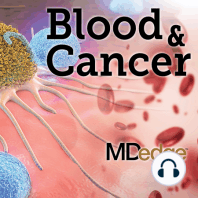30 min listen

ISTH 2020: Dr. Hanny Al-Samkari talks VTE in COVID-19, bevacizumab in HHT, and predisposition to thrombosis in NSCLC
FromBlood & Cancer
ISTH 2020: Dr. Hanny Al-Samkari talks VTE in COVID-19, bevacizumab in HHT, and predisposition to thrombosis in NSCLC
FromBlood & Cancer
ratings:
Length:
33 minutes
Released:
Aug 13, 2020
Format:
Podcast episode
Description
Hanny Al-Samkari, MD, joins the podcast to discuss thrombosis in COVID-19 and lung cancer patients as well as the use of bevacizumab in patients with hereditary hemorrhagic telangiectasia (HHT). Dr. Al-Samkari, of Massachusetts General Hospital, presented three studies on these topics at the virtual ISTH 2020 Congress. In this episode, Dr. Al-Samkari describes these studies to host David H. Henry, MD. Thrombosis, Bleeding, and the Effect of Anticoagulation on Survival in Critically Ill Patients with COVID-19 in the United States This 67-center study included 3,239 critically ill adults with COVID-19. The 14-day incidence of radiographically confirmed venous thromboembolism (VTE) was 6.3%. The 14-day incidence of strictly defined major bleeding was 2.8%. Patients who received therapeutic anticoagulation in the first 2 days of ICU admission had a similar risk of death at 28 days as patients who did not receive anticoagulation. Al-Samkari H et al. ISTH 2020, Abstract LB/CO01.2. https://bit.ly/3alvquE. An International Multicenter Study of Bevacizumab for Bleeding in Hereditary Hemorrhagic Telangiectasia — The InHIBIT-Bleed Study This 12-center trial included 238 patients with HHT. Patients received bevacizumab for a median of 12 months (range, 1-96 months). The most common dosing schedule was 5 mg/kg every 2-4 weeks for four to six treatments of induction, followed by maintenance. During the first year, bevacizumab increased the mean hemoglobin by 3.2 g/dL. At 6 months post treatment, transfusions of red blood cells had decreased by 82% and iron infusions had decreased by 70%. Al-Samkari H et al. ISTH 2020, Abstract OC 9.2. https://bit.ly/30L5PrV. The ALK Rearrangement is a Major Risk Factor for Venous and Arterial Thrombosis in Non–Small Cell Lung Cancer This retrospective study included patients with advanced non–small cell lung cancer (NSCLC). There were 422 patients with ALK-rearranged NSCLC and 385 with non–ALK-rearranged NSCLC. The rate of initial VTE was 42.7% in ALK and 28.6% in non-ALK NSCLC. The rate of recurrent VTE was 13.5% in ALK and 3.1% in non-ALK NSCLC. Arterial thrombosis rates were similar in ALK and non-ALK NSCLC (5.0% and 4.4%, respectively). In analyses controlling for time and thrombosis risk factors, the risk of VTE was three times higher and the risk of arterial thrombosis was four times higher among patients with ALK rearrangement. Al-Samkari H et al. ISTH 2020, Abstract OC 10.2. https://bit.ly/30KHouB. Disclosures: Dr. Al-Samkari has no relevant disclosures. Dr. Henry has no relevant disclosures. * * * For more MDedge Podcasts, go to mdedge.com/podcasts Email the show: podcasts@mdedge.com Interact with us on Twitter: @MDedgehemonc David Henry on Twitter: @davidhenrymd
Released:
Aug 13, 2020
Format:
Podcast episode
Titles in the series (100)
Common bleeding and coagulation issues: There’s an art to taking a thorough bleeding history. In this episode, , director of the Hemophilia and Thrombosis Center at the University of Pennsylvania, Philadelphia, shares the most important questions to ask and the challenges in assessing... by Blood & Cancer